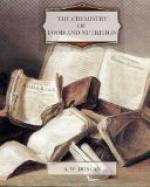We have given reasons of a scientific character, for abstaining from flesh as food, but higher than these are those relating to ethics. Everything relating to the slaughter-house is revolting to a refined and humane person. In the great slaughter-houses of Chicago; in those huge hideous box-shaped buildings, five or six storeys high, about ten millions of animals are killed every year. They are treated as if they were bales of merchandise and as destitute of feeling. Bullocks are struck on the head with a mallet and let fall into the basement of the building. They are whilst stunned or half-stunned, at once strung up by their hind legs to some machinery, which moves them along, their heads hanging downwards. Regardless of their agony, men run after them to cut their throats, followed by others with great pails to catch the blood. Much of the warm blood is spilt over the men or on the floors; but this is of no consequence, if but a small fraction of a minute is economised. In a short time, whether the animal has bled long enough or not, it reaches the lowest and darkest and worst ventilated portion of the gloomy building, where it is disembowelled. The walls and floors are caked with blood, the place is filthy, there is no proper lavatory accommodation, everything both to eyes and nose is detestable. Even if the windows were kept clean, light could not penetrate into the centre of the buildings. Consequently a large part of the work is done by artificial light. Tuberculosis is prevalent amongst the workpeople living under such unsanitary conditions. Serious crime is much more common amongst them than amongst any other class.




